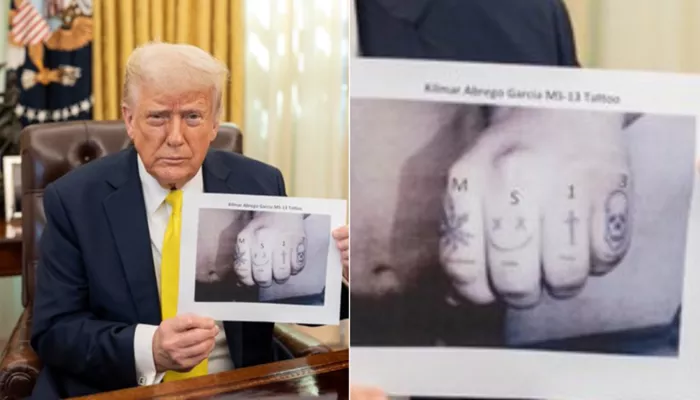President Donald Trump’s increasing use of tattoos as evidence of gang membership has sparked criticism from experts, who argue that the practice is flawed and misleading, particularly in the context of his push to deport undocumented migrants, especially those from Venezuela. Trump recently highlighted the case of Kilmar Abrego Garcia, a 29-year-old Maryland resident deported to El Salvador on March 15, despite an active immigration court order blocking his removal.
Trump shared an image of tattooed knuckles allegedly belonging to Abrego Garcia, asserting: “This is the hand of the man that the Democrats feel should be brought back to the United States, because he is such ‘a fine and innocent person.’ They said he is not a member of MS-13, even though he’s got MS-13 tattooed on his knuckles… I must be allowed to do my job. MAKE AMERICA GREAT AGAIN!”
However, several law enforcement officials and experts have expressed concerns about the growing reliance on tattoos as a determining factor for gang affiliation—particularly with regard to the Venezuelan gang Tren de Aragua. Joseph Kenny, chief of detectives at the New York Police Department, emphasized in a New York Times report that “a tattoo itself is never sufficient evidence to prove a person is a member of a criminal group.”
Internal guidelines used by U.S. immigration officials now include a 10-point scoring system, in which tattoos can earn up to four points toward determining deportability under the Alien Enemies Act. Eight points are required for expedited removal without a hearing. In one case, Andry Jose Hernandez Romero, a Venezuelan makeup artist, was deported to El Salvador based solely on tattoos reading “Mom” and “Dad” inside crowns.
Experts, including police officers, academics, and journalists, told the New York Times that tattoos, such as clocks, skulls, or train imagery, may be associated with Tren de Aragua but are not formal indicators of gang membership within Venezuelan street culture. Tattoos are common among young men in Venezuela, regardless of their affiliation.
The controversy surrounding Kilmar Abrego Garcia’s case has intensified public debate. A New York Times investigation debunked viral claims that his finger tattoos spelled out “MS-13” with symbols like a marijuana leaf, smiley face, cross, and skull. U.S. Immigration and Customs Enforcement (ICE) officials told The Washington Post that these symbols are not associated with MS-13. However, ICE arrest records mentioned other tattoos—such as skulls with covered eyes, ears, and mouths (a “see no evil” motif) and a devil with horns—as signs of seniority within MS-13. A Chicago Bulls cap was also cited as evidence of gang ties.
Despite a Supreme Court ruling that upheld the lower court’s decision to reverse Garcia’s deportation, the White House has remained steadfast in its position. Press Secretary Karoline Leavitt stated that “Abrego Garcia will never live in the United States of America,” reiterating accusations of gang affiliation.
Meanwhile, El Salvador’s President Nayib Bukele mocked the accusations of mistreatment, posting images of Abrego Garcia enjoying margaritas with Senator Chris Van Hollen. “Kilmar Abrego Garcia, miraculously risen from the ‘death camps’ & ‘torture,’ now sipping margaritas with Sen. Van Hollen,” Bukele wrote on X.
Legal experts have cautioned that tattoos, while potentially indicative of gang affiliation, are rarely used as the sole evidence in legal proceedings. Ryan Brackley, assistant district attorney in Arapahoe County, Colorado, stated, “A tattoo can be very telling. But are we going to base our decisions and law enforcement accusations and associations on a tattoo? Very, very unlikely.”
John Colello, a gang homicide division prosecutor in Los Angeles County, echoed this sentiment, emphasizing the importance of context. “Facts and context are obviously important. Tattoos alone, or lack of tattoo, do not necessarily mean a person is, or is not, a gang member,” he said.
Related topics:

